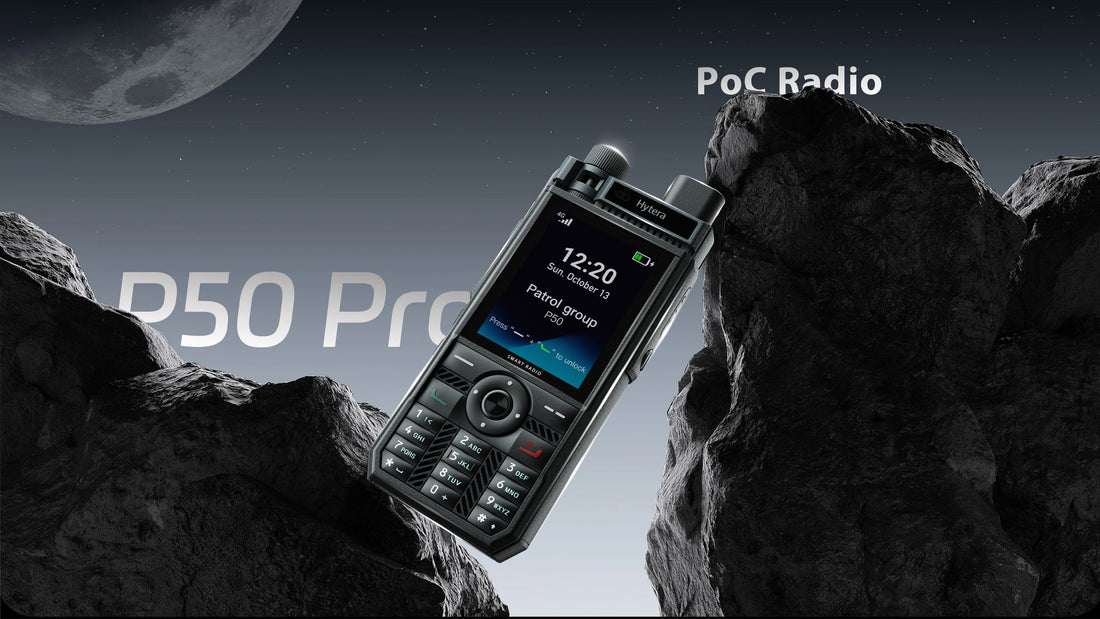
Tired of Dead Zones and Static? Here’s How PoC Radios Solve Communication Gaps
Share
Introduction: Why Reliable Communication Still Matters
Even in our age of smartphones and high-speed data, clear and consistent communication remains a daily challenge for many teams in Singapore. From construction sites in Tuas to security patrols across Marina Bay or delivery fleets traversing expressways — staying connected without disruption is crucial.
Yet, how often have you heard these frustrations?
“Can you hear me?”
“Your signal’s breaking up!”
“We lost contact in the tunnel again.”
Traditional two-way radios and even some mobile apps often struggle with dead zones, static, and limited range, especially in urban or underground environments.
Enter Push-to-Talk over Cellular (PoC) radios — a next-generation solution that combines the instant communication of walkie-talkies with the nationwide coverage of Singapore’s 4G/LTE networks.
This post explores how PoC technology solves communication gaps, enhances team coordination, and future-proofs your business communications — no matter where your operations take you.
1. The Persistent Problem: Dead Zones, Static, and Coverage Limitations
Despite technological advancements, coverage gaps remain a stubborn issue for many industries relying on traditional radio systems.
a. Limited range of traditional radios
Conventional VHF/UHF radios typically cover 1–5 km in open areas, but dense urban environments — with high-rise buildings, steel structures, and underground car parks — drastically reduce range and signal strength.
b. Static and interference
Analog radios often suffer from electromagnetic interference, static noise, and overlapping channels — particularly in busy city areas where multiple frequencies are in use.
c. Repeater and licensing costs
To expand coverage, businesses often invest in radio repeaters, antennas, and IMDA frequency licences. These add layers of cost, complexity, and maintenance — especially when operating across multiple sites.
d. Connectivity blind spots
Teams working in basements, tunnels, or industrial zones frequently encounter “dead spots,” where signals simply don’t penetrate. Communication breaks at the exact moment it’s needed most — during an emergency, dispatch, or time-critical coordination.
These challenges directly affect productivity and safety — making it clear why many Singapore businesses are now switching to PoC radios for uninterrupted, crystal-clear communication.
2. Enter PoC: Push-to-Talk Over Cellular Explained
What is PoC?
Push-to-Talk over Cellular (PoC) uses existing 4G/LTE networks instead of radio frequencies. That means your communication coverage extends island-wide — wherever there’s mobile signal.
PoC radios connect over mobile data or Wi-Fi, delivering instant voice communication, real-time location tracking, and multimedia capabilities — all from rugged, professional-grade devices.
How it works
When a user presses the talk button, their voice is transmitted via the cellular data network to Hytera’s PoC platform or server, then relayed to selected group members — whether they’re 200 metres or 20 kilometres away.
The result? Zero dead zones and no need for repeaters — just plug, push, and talk.
3. Key Ways PoC Radios Eliminate Communication Gaps
Let’s explore how PoC technology directly addresses the most common pain points of traditional radios.
a. Island-Wide Coverage — No Repeaters Required
Unlike traditional radios limited by line-of-sight, Hytera PoC radios leverage 4G/LTE networks from major Singapore telcos.
This gives you seamless coverage from Changi to Tuas, Sentosa to Woodlands — all without the need for repeaters or frequency coordination.
This is particularly valuable for:
- Fleet operators managing deliveries across Singapore.
- Security teams patrolling wide areas like industrial parks, ports, or retail districts.
- Event management crews moving between venues or zones.
b. Crystal-Clear Audio Quality
Digital PoC radios use noise suppression and audio enhancement algorithms, delivering crisp, distortion-free communication — even in noisy environments like construction sites or airports.
No more static, muffled voices, or “can you repeat that?” moments.
c. Multi-Channel & Group Communication
Hytera PoC radios support individual calls, group calls, and broadcast calls — letting supervisors communicate with entire teams or specific individuals instantly.
You can configure talk groups by department, zone, or function (e.g., drivers, dispatchers, supervisors).
d. Smart Device Management
Using Hytera’s PoC platform (Hytalk), administrators can manage, track, and monitor all devices from a central dashboard:
- View GPS locations in real time.
- Create or delete talk groups instantly.
- Replay call logs or voice messages.
- Send text or image messages to teams in the field.
e. Reliable Network Redundancy
Because PoC uses 4G/LTE and Wi-Fi, teams can switch between networks automatically — ensuring communication continuity even during network transitions or outages.
4. Industry Use Cases: Where PoC Makes the Biggest Difference
Security & Facilities Management
Security personnel working in large malls or industrial estates often lose signal when moving between basements, rooftops, or outdoor patrol routes.
PoC radios maintain stable communication across all zones, allowing instant response and coordination.
Key benefits:
- Island-wide coverage
- Emergency alarm & lone worker protection
- GPS tracking and dispatch control
Transportation & Logistics
Delivery drivers, dispatchers, and warehouse teams rely on synchronized updates to avoid bottlenecks.
With PoC, they can coordinate routes, report delays, and share updates instantly — even while on the expressway.
Key benefits:
- Real-time GPS tracking
- Nationwide voice & data communication
- Group calling for dispatch teams
Construction & Engineering
At complex worksites, communication between ground teams, crane operators, and supervisors can be disrupted by interference or distance.
PoC eliminates this issue, enabling clear, secure communication across the entire project site.
Key benefits:
- High-volume group communication
- Rugged, IP67-rated devices for dust and water resistance
- Instant messaging for progress updates
Events & Crowd Management
Event crews often span multiple locations — from control rooms to stages to parking zones.
PoC ensures that coordination remains smooth and reliable, even in high-density environments.
Key benefits:
- Multi-channel coordination
- Easy integration with smartphones and dispatch apps
- Instant system setup (no repeaters or wiring needed)
F&B and Hospitality
Hotel staff, kitchen teams, and service managers can stay in touch seamlessly across floors or branches — improving guest experience and operational efficiency.
Key benefits:
- Discreet, compact radios with clear audio
- Instant alerts for service or emergencies
- LTE connectivity for multi-site operations
5. Why Hytera PoC Radios Stand Out
Hytera, a global leader in professional communication systems, designs PoC solutions built for reliability and enterprise scalability.
a. Hytera PNC Series Radios
- PNC380: Compact, lightweight, and ideal for hospitality or retail use.
- PNC460: With a built-in camera for video capture and Bluetooth connectivity.
- PNC460U: Android-based smart PoC device that doubles as a smartphone — perfect for supervisors and mobile teams.
b. Hytera Hytalk Platform
The Hytalk platform powers centralized management, real-time tracking, and flexible group communication — turning your radios into an intelligent dispatch network.
c. IMDA Compliance
All Hytera PoC radios are IMDA-approved for Singapore use — ensuring legal operation, certified quality, and local support.
d. Local Support and Integration
With a strong presence in Singapore, Hytera partners provide setup, training, and technical support — ensuring smooth deployment for businesses of any size.
6. The Future of Communication is PoC
As Singapore continues its Smart Nation transformation, reliable connectivity is no longer optional — it’s a necessity.
From logistics to security to public services, real-time, uninterrupted communication drives both safety and efficiency.
PoC radios represent the next step in that evolution:
- They remove the boundaries of range-limited radios.
- They eliminate static and interference.
- They integrate with digital tools like GPS, dispatch systems, and AI-driven analytics.
In short — they bring communication into the LTE era.
7. Getting Started: How to Transition to PoC Radios
Transitioning to PoC is simpler than many expect.
-
Assess your communication pain points.
Identify where traditional radios are failing — whether it’s coverage, clarity, or management. -
Select suitable PoC devices.
Choose from Hytera’s range based on your operational needs — compact for hospitality, rugged for construction, or hybrid for fleet operations. -
Integrate with dispatch software.
Use Hytera Hytalk for location tracking, message recording, and group setup. -
Train your teams.
The learning curve is minimal — but training ensures every team member understands group calling, emergency functions, and GPS reporting. -
Monitor & optimize.
Use the management dashboard to refine group structures and monitor communication trends.
Conclusion: Say Goodbye to Dead Zones and Static
Communication breakdowns aren’t just frustrating — they can lead to missed opportunities, safety risks, and operational delays.
By switching to Hytera PoC radios, Singapore businesses can finally say goodbye to:
❌ Dead zones
❌ Static and interference
❌ Limited range
❌ Costly infrastructure
And hello to:
✅ Island-wide LTE coverage
✅ Clear, reliable voice communication
✅ Smarter dispatch and location tracking
✅ Scalable, IMDA-approved solutions
So if you’re tired of saying “Can you hear me?” — it’s time to upgrade to PoC and enjoy the clarity your team deserves.
